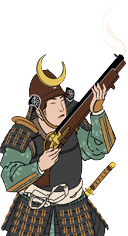
Basic Unit Statistics (can be modified by difficulty level, arts, skills, traits and retainers)
| Recruitment Cost | 1100 | |
| Upkeep Cost | 200 | |
| Melee Attack | 6 | 17% |
| Charge Bonus | 6 | 12% |
| Bonus vs Cavalry | 0 | 0% |
| Range | 100 | 15% |
| Accuracy | 50 | 50% |
| Reloading Skill | 20 | 20% |
| Ammunition | 15 | 18% |
| Melee Defence | 2 | 5% |
| Armour | 4 | 26% |
| Morale | 8 | 16% |
Strengths & Weaknesses
- Very large muskets can heavily damage units and buildings.
- Small unit size leaves them vulnerable in melee.
- Very vulnerable to cavalry.
Description
For some targets a simple musket is disrespectful. Better by far to use a heavy gun.
These gunners carry immensely powerful, heavy pieces. The large calibre bullets fired from the oversized barrels will not only kill, but can also do damage to buildings. The guns are expensive and weighty; they are in short supply as are men strong enough to use them. As a result, the unit is numerically rather small, and this will count against them in close combat. The musketeers also move relatively slowly, leaving them vulnerable to cavalry attacks. European "harquebuses" of the period came in many different sizes and calibres. Standardisation was almost unknown, and some of the huge bullets fired look ridiculously large to modern eyes. However, when Portuguese traders were blown off course and arrived in Japan, the Shimazu were quick to recognise the military worth of the two guns aboard the vessel. Their master weaponsmith was a master sword maker but, sadly, this did not help him copy the European guns. Eventually a deal was done: the smith got lessons in gun making from a second group of Portuguese traders; they got the smith's daughter. A harsh bargain for harsh times, perhaps.